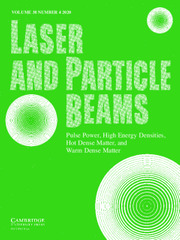Crossref Citations
This article has been cited by the following publications. This list is generated based on data provided by
Crossref.
Pšikal, J.
Limpouch, J.
Kawata, S.
and
Andreev, A. A.
2006.
Pic simulations of femtosecond interactions with mass-limited targets.
Czechoslovak Journal of Physics,
Vol. 56,
Issue. S2,
p.
B515.
Ter-Avetisyan, S.
Schnürer, M.
Nickles, P. V.
Kalashnikov, M.
Risse, E.
Sokollik, T.
Sandner, W.
Andreev, A.
and
Tikhonchuk, V.
2006.
Quasimonoenergetic Deuteron Bursts Produced by Ultraintense Laser Pulses.
Physical Review Letters,
Vol. 96,
Issue. 14,
Lontano, Maurizio
and
Passoni, Matteo
2006.
Electrostatic field distribution at the sharp interface between high density matter and vacuum.
Physics of Plasmas,
Vol. 13,
Issue. 4,
Schnürer, M.
Ter-Avetisyan, S.
Nickles, P. V.
and
Andreev, A. A.
2007.
Influence of target system on the charge state, number, and spectral shape of ion beams accelerated by femtosecond high-intensity laser pulses.
Physics of Plasmas,
Vol. 14,
Issue. 3,
Limpouch, J.
Psikal, J.
Andreev, A.A.
Platonov, K. YU.
and
Kawata, S.
2008.
Enhanced laser ion acceleration from mass-limited targets.
Laser and Particle Beams,
Vol. 26,
Issue. 2,
p.
225.
Bagchi, S.
Prem Kiran, P.
Bhuyan, M.K.
Bose, S.
Ayyub, P.
Krishnamurthy, M.
and
Ravindra Kumar, G.
2008.
Hotter electrons and ions from nano-structured surfaces.
Laser and Particle Beams,
Vol. 26,
Issue. 2,
p.
259.
Andreev, A.
Platonov, K.
and
Kawata, S.
2009.
Ion acceleration by short high intensity laser pulse in small target sets.
Laser and Particle Beams,
Vol. 27,
Issue. 3,
p.
449.
Sokollik, T.
Schnürer, M.
Steinke, S.
Nickles, P. V.
Sandner, W.
Amin, M.
Toncian, T.
Willi, O.
and
Andreev, A. A.
2009.
Directional Laser-Driven Ion Acceleration from Microspheres.
Physical Review Letters,
Vol. 103,
Issue. 13,
Sokollik, T
Paasch-Colberg, T
Gorling, K
Eichmann, U
Schnürer, M
Steinke, S
Nickles, P V
Andreev, A
and
Sandner, W
2010.
Laser-driven ion acceleration using isolated mass-limited spheres.
New Journal of Physics,
Vol. 12,
Issue. 11,
p.
113013.
Nath, A.
and
Khare, A.
2011.
Transient evolution of multiple bubbles in laser induced breakdown in water.
Laser and Particle Beams,
Vol. 29,
Issue. 1,
p.
1.
Schnürer, M.
Andreev, A.A.
Steinke, S.
Sokollik, T.
Paasch-Colberg, T.
Nickles, P.V.
Henig, A.
Jung, D.
Kiefer, D.
Hörlein, R.
Schreiber, J.
Tajima, T.
Habs, D.
and
Sandner, W.
2011.
Comparison of femtosecond laser-driven proton acceleration using nanometer and micrometer thick target foils.
Laser and Particle Beams,
Vol. 29,
Issue. 4,
p.
437.
Paasch-Colberg, T.
Sokollik, T.
Gorling, K.
Eichmann, U.
Steinke, S.
Schnürer, M.
Nickles, P.V.
Andreev, A.
and
Sandner, W.
2011.
New method for laser driven ion acceleration with isolated, mass-limited targets.
Nuclear Instruments and Methods in Physics Research Section A: Accelerators, Spectrometers, Detectors and Associated Equipment,
Vol. 653,
Issue. 1,
p.
30.
Sokollik, Thomas
2011.
Investigations of Field Dynamics in Laser Plasmas with Proton Imaging.
p.
83.
Di Lucchio, Laura
Andreev, Alexander A.
and
Gibbon, Paul
2015.
Ion acceleration by intense, few-cycle laser pulses with nanodroplets.
Physics of Plasmas,
Vol. 22,
Issue. 5,
p.
053114.
Price, C. J.
Donnelly, T. D.
Giltrap, S.
Stuart, N. H.
Parker, S.
Patankar, S.
Lowe, H. F.
Drew, D.
Gumbrell, E. T.
and
Smith, R. A.
2015.
An in-vacuo optical levitation trap for high-intensity laser interaction experiments with isolated microtargets.
Review of Scientific Instruments,
Vol. 86,
Issue. 3,
Ostermayr, T. M.
Haffa, D.
Hilz, P.
Pauw, V.
Allinger, K.
Bamberg, K.-U.
Böhl, P.
Bömer, C.
Bolton, P. R.
Deutschmann, F.
Ditmire, T.
Donovan, M. E.
Dyer, G.
Gaul, E.
Gordon, J.
Hegelich, B. M.
Kiefer, D.
Klier, C.
Kreuzer, C.
Martinez, M.
McCary, E.
Meadows, A. R.
Moschüring, N.
Rösch, T.
Ruhl, H.
Spinks, M.
Wagner, C.
and
Schreiber, J.
2016.
Proton acceleration by irradiation of isolated spheres with an intense laser pulse.
Physical Review E,
Vol. 94,
Issue. 3,
Morrison, John T
Feister, Scott
Frische, Kyle D
Austin, Drake R
Ngirmang, Gregory K
Murphy, Neil R
Orban, Chris
Chowdhury, Enam A
and
Roquemore, W M
2018.
MeV proton acceleration at kHz repetition rate from ultra-intense laser liquid interaction.
New Journal of Physics,
Vol. 20,
Issue. 2,
p.
022001.
Puyuelo-Valdes, P.
Henares, J. L.
Hannachi, F.
Ceccotti, T.
Domange, J.
Ehret, M.
d'Humieres, E.
Lancia, L.
Marquès, J.-R.
Ribeyre, X.
Santos, J. J.
Tikhonchuk, V.
and
Tarisien, M.
2019.
Proton acceleration by collisionless shocks using a supersonic H2 gas-jet target and high-power infrared laser pulses.
Physics of Plasmas,
Vol. 26,
Issue. 12,
Becker, Georg A.
Schwab, Matthew B.
Lötzsch, Robert
Tietze, Stefan
Klöpfel, Diethard
Rehwald, Martin
Schlenvoigt, Hans-Peter
Sävert, Alexander
Schramm, Ulrich
Zepf, Matt
and
Kaluza, Malte C.
2019.
Characterization of laser-driven proton acceleration from water microdroplets.
Scientific Reports,
Vol. 9,
Issue. 1,
Jiang, K
Zhou, C T
Huang, T W
Ju, L B
Wu, C N
Li, L
Zhang, H
Wu, S Z
Cai, T X
Qiao, B
Yu, M Y
and
Ruan, S C
2019.
Divergence and direction control of laser-driven energetic proton beam using a disk-solenoid target.
Plasma Physics and Controlled Fusion,
Vol. 61,
Issue. 7,
p.
075004.


